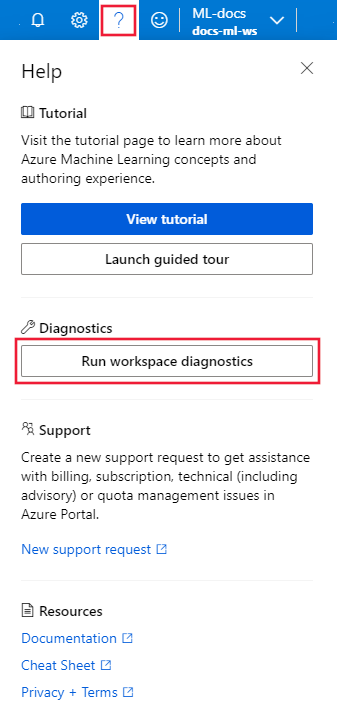How to use workspace diagnostics
APPLIES TO:  Python SDK azure-ai-ml v2 (current)
Python SDK azure-ai-ml v2 (current)
APPLIES TO:  Python SDK azureml v1
Python SDK azureml v1
Azure Machine Learning provides a diagnostic API that can be used to identify problems with your workspace. Errors returned in the diagnostics report include information on how to resolve the problem.
You can use the workspace diagnostics from the Azure Machine Learning studio or Python SDK.
Prerequisites
Before following the steps in this article, make sure you have the following prerequisites:
An Azure Machine Learning workspace. If you don't have one, use the steps in the Quickstart: Create workspace resources article to create one.
To install the Python SDK v2, use the following command:
pip install azure-ai-ml azure-identityTo update an existing installation of the SDK to the latest version, use the following command:
pip install --upgrade azure-ai-ml azure-identityFor more information, see Install the Python SDK v2 for Azure Machine Learning.
- An Azure Machine Learning workspace. If you don't have one, see Create a workspace.
- The Azure Machine Learning SDK v1 for Python.
Diagnostics from studio
From the Azure Machine Learning studio, you can run diagnostics on your workspace to check your setup. To run diagnostics, select the '?' icon in the upper right corner of the page. Then select Run workspace diagnostics.

After diagnostics run, a list of any detected problems is returned. This list includes links to possible solutions.
Diagnostics from Python
The following snippet demonstrates how to use workspace diagnostics from Python.
APPLIES TO:  Python SDK azure-ai-ml v2 (current)
Python SDK azure-ai-ml v2 (current)
from azure.ai.ml import MLClient
from azure.ai.ml.entities import Workspace
from azure.identity import DefaultAzureCredential
subscription_id = '<your-subscription-id>'
resource_group = '<your-resource-group-name>'
workspace = '<your-workspace-name>'
ml_client = MLClient(DefaultAzureCredential(), subscription_id, resource_group)
resp = ml_client.workspaces.begin_diagnose(workspace).result()
# Inspect the attributes of the response you are interested in
for result in resp.application_insights_results:
print(f"Diagnostic result: {result.code}, {result.level}, {result.message}")
The response is a DiagnoseResponseResultValue object that contains information on any problems detected with the workspace.
APPLIES TO:  Python SDK azureml v1
Python SDK azureml v1
from azureml.core import Workspace
ws = Workspace.from_config()
diag_param = {
"value": {
}
}
resp = ws.diagnose_workspace(diag_param)
print(resp)
The response is a JSON document that contains information on any problems detected with the workspace. The following JSON is an example response:
{
"value": {
"user_defined_route_results": [],
"network_security_rule_results": [],
"resource_lock_results": [],
"dns_resolution_results": [{
"code": "CustomDnsInUse",
"level": "Warning",
"message": "It is detected VNet '/subscriptions/<subscription-id>/resourceGroups/<resource-group-name>/providers/Microsoft.Network/virtualNetworks/<virtual-network-name>' of private endpoint '/subscriptions/<subscription-id>/resourceGroups/<myresourcegroup>/providers/Microsoft.Network/privateEndpoints/<workspace-private-endpoint>' is not using Azure default DNS. You need to configure your DNS server and check https://learn.microsoft.com/azure/machine-learning/how-to-custom-dns to make sure the custom DNS is set up correctly."
}],
"storage_account_results": [],
"key_vault_results": [],
"container_registry_results": [],
"application_insights_results": [],
"other_results": []
}
}
If no problems are detected, an empty JSON document is returned.
For more information, see the Workspace reference.
For more information, see the Workspace.diagnose_workspace() reference.
Next step
Povratne informacije
Uskoro: tokom 2024. postepeno ćemo ukidati probleme s uslugom GitHub kao mehanizam povratnih informacija za sadržaj i zamijeniti ga novim sistemom povratnih informacija. Za više informacija, pogledajte https://aka.ms/ContentUserFeedback.
Pošalјite i prikažite povratne informacije za